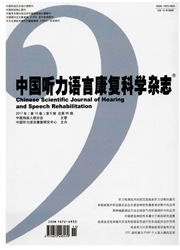

 中文摘要:
中文摘要:
目的分析蜗神经管狭窄患者人工耳蜗植入术后听觉言语康复效果与耳蜗形态结构正常患者之间的差异。方法回顾性分析2007~2015年在北京友谊医院行人工耳蜗植入患者的临床资料,选取其中手术侧蜗神经管狭窄患者6例(6耳)及耳蜗形态结构正常患者6例(6耳),对两组患者术后6个月的听觉行为分级标准(categories of auditory performance,CAP)、言语可懂度分级标准(speechintelligibilityrating,sIR)和婴幼儿有意义听觉整合量表(infant-toddler meaningful auditory integration scale,IT—MAIS)得分进行分析和比较。结果蜗神经管狭窄组术后6个月的CAP、SIR以及IT—MAIS得分均低于耳蜗形态结构正常组,两组间CAP和IT—MAIS的差异具有统计学意义(P〈0.05),而SIR的差异无统计学意义(P〉0.05)。结论蜗神经管狭窄患者的术后听觉康复效果较耳蜗形态结构发育正常患者差,言语可懂度在两者之间无显著性差异,远期效果有待干进一步随访。
 英文摘要:
英文摘要:
Objective To compare the auditory and speech rehabilitation outcomes between patients with cochlear nerve canal stenosis(CNCS) and normal cochlear structure after cochlear implantation. Methods Twelve profoundly hearing-impaired patients were recruited in this study, including 6 with CNCS and 6 with normal anatomic structure. They all received cochlear implantation from 2007 to 2015.The infant-toddler meaningful auditory integration scale (IT- MAIS), categories of auditory performance (CAP) and speech intelligibility rating (SIR) were used to evaluate the auditory and speech abilities of patients 6 months after cochlear implantation. The results were compared between the two groups. Results The results showed that there were significant differences between the two groups in CAP and IT-MAIS scores (P〈0.05), but no significant differences in SIR scores (P〉0.05) 6 months after cochlear inplantation. Conclusions The auditory abilities of patients with CNCS are poorer than patients with normal anatomic structure,but the SIR scores show no obvious difference between the two groups.
 同期刊论文项目
同期刊论文项目
 同项目期刊论文
同项目期刊论文
 期刊信息
期刊信息
